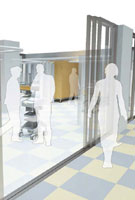Prescription for Success
By Carie Braun '92
Chair, CSB/SJU Nursing Department
 The health care system has changed remarkably in the past 10 years. Hallmarks of today's health care environment include:
The health care system has changed remarkably in the past 10 years. Hallmarks of today's health care environment include:
· Greater complexity of illness
• Shorter hospitalizations
· Significant use of ever-changing technologies
• Increased cultural diversity
· Focus on achieving optimal health outcomes at the lowest cost.
Further, nursing and other health care services are increasingly delivered in community-based settings such as clinics and homes. These settings are riddled with inherent unpredictability.
Developments in patient monitoring and information technologies (including electronic messaging, medical records, data collection, and reporting systems) require students to demonstrate expertise in interpretation and electronic communication.
The health care professional of the future must enter the arena having had significant learning experiences with simulated and actual patients along with the electronic documentation systems to support care decision-making. Future practitioners must become innovative, creative, culturally competent, flexible, and adaptable in order to respond quickly and effectively to the accelerated rate of change found in health care settings.
Saint Ben's and Saint John's have demonstrated a strong commitment to preparing baccalaureate nurses in the liberal arts tradition. The nursing program graduated its first class 37 years ago. The demand for and popularity of the major with its extreme rigor and emphasis on leadership, professionalism, and quality remains strong still today. Nursing is the fifth largest major at CSB and SJU. We have 91 upper division majors and 158 pre-nursing students awaiting admission to the major.
A key element of our program is simulations, or SIMS, where students interact with high-tech mannequins or live actors. Simulations were designed as effective, complex, and reflective learning situations where observations of the student's performance could be assessed and evaluated prior to a student's placement in an actual clinical setting. SIMS provided students with the ability to better understand, practice, and master what may occur in a real patient interaction.
Our knowledge of how to promote effective learning in the simulation laboratory has exponentially outgrown our current facilities. In short, the existing nursing facilities are at the end of their useful life and in need of significant upgrades to meet modern academic and industry standards and to continue and augment the fine programming that is occurring despite the sub-standard quality of existing spaces.
Rationale for Space and Equipment Needs
The nursing department has been housed on the 4th floor of the Main Building since the early 1970s. Since then, one remodeling project was completed in 1984, but the total learning space remained approximately 1600 square feet since the program's inception.
In addition to classrooms and offices, our current lab space includes:
· two ward-style labs that house 5 to 7 beds
· one small 8x8 patient room that tightly houses a bed, chair, computer station, and a few square feet for nurse movement
· a closet that toggles between storage space and a simulated living room for home health care visits
All four of these spaces provide challenges to effective teaching and learning, including inadequate or nonexistent areas for observation and reflection. In fact, the patient room and home visit spaces require faculty and students to huddle together and peer through cracked-open doorways in order to see and hear what is transpiring in the simulation.
Data from students, potential students, faculty, our community advisory aboard, and nursing literature support the need for a redesigned and re-equipped learning space. A significant survey of enrolled nursing students indicated that the available equipment and spaces hindered learning. Students commented that poor ventilation (overheating and inadequate air movement), small desks and chairs, and poor lighting interfered with concentration and performance. Current equipment was perceived as inadequate and poorly representative of the equipment encountered in clinical settings. Students also indicated concern with lack of compatibility between computer systems and software.
A nursing faculty task group investigated local and national learning laboratory standards. In addition to site visits, they networked with experts across the country via e-mail and at national conferences to more fully understand the current and expanding role of nursing laboratories in baccalaureate nursing programs. The process culminated in hiring a laboratory design consultant who provided invaluable recommendations for change.
The architectural renderings on the following pages offer a glimpse of what could be incorporated into a renovation of the nursing department. The renovation comes with a multimillion dollar price tag.
We invite you to consider taking part in this prescription for future success. Consider a lead gift to name the nursing facility or sponsor SIM labs, community spaces, the resource center, or classrooms.
Contact 1.800.648.3468, ext. 6 to learn more.

